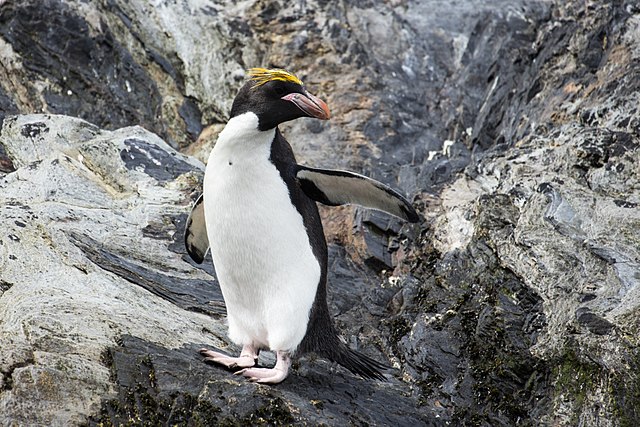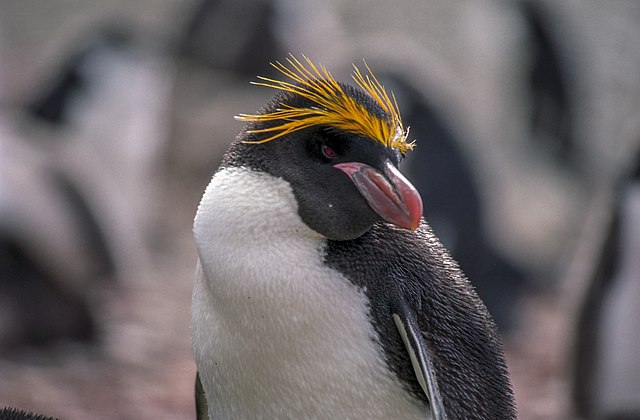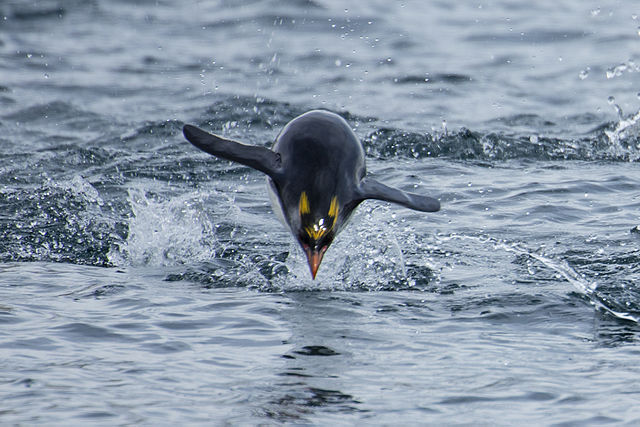Macaroni penguins are a species of penguin known for their distinctive yellow crests and vibrant personalities. Here are 50 interesting facts about Macaroni penguins:
Taxonomy and Classification:
Scientific Name: The scientific name for the Macaroni penguin is Eudyptes chrysolophus.
Crested Penguins: Macaroni penguins are part of the crested penguin group, characterized by their colorful crests and distinctive markings.
Subspecies: There are several subspecies of Macaroni penguins, each with slightly different physical characteristics.
Physical Characteristics:
Size: Macaroni penguins are medium-sized penguins, typically standing between 20 to 28 inches (50 to 70 cm) tall.
Weight: They weigh around 4.4 to 11 pounds (2 to 5 kilograms).
Plumage: Adults have a black back and white underside. Their most prominent feature is their bright orange-yellow crests that extend from their foreheads to their cheeks.
Eye Color: Their eyes have reddish-brown irises.

Distribution:
Range: Macaroni penguins primarily breed on subantarctic and Antarctic islands, including South Georgia, the South Sandwich Islands, the South Orkney Islands, and the South Shetland Islands.
Breeding and Nesting:
Colonies: They breed in large colonies, often numbering in the thousands or tens of thousands.
Nesting Sites: Macaroni penguins typically nest on rocky, steep, and sometimes high cliffs.
Nesting Material: They construct their nests from stones and pebbles.
Mating Behavior: They usually mate for life, and pairs often engage in courtship rituals like mutual preening.
Eggs: Females lay one or two eggs per breeding season.
Incubation: Both the male and female take turns incubating the eggs.
Diet:
Diet Composition: Macaroni penguins primarily feed on krill but also eat other small crustaceans and fish.
Foraging: They are efficient divers and can dive to depths of up to 200 meters (656 feet) to forage for food.
Predators:
Predation: Macaroni penguins face predation from a variety of seabirds and marine mammals, including skuas and leopard seals.
Behavior:
Vocalizations: They produce a variety of vocalizations, including braying sounds that resemble donkey calls.
Grooming: Macaroni penguins are meticulous groomers and often preen their feathers to keep them clean and waterproof.

Conservation Status:
IUCN Status: The Macaroni penguin is listed as a species of “Least Concern” by the International Union for Conservation of Nature (IUCN).
Population Trends: Some populations of Macaroni penguins have experienced declines, while others have remained stable or increased.
Climate Change and Conservation:
Impact of Climate Change: Climate change can affect their food sources, as it can alter the distribution of krill and other prey species.
Conservation Efforts: Various organizations and researchers are monitoring Macaroni penguin populations and studying their behavior to better understand their needs and protect their habitats.
Social Structure:
Sociable Penguins: Macaroni penguins are known for their social nature and are often seen in large groups.
Colonial Nesting: They nest in dense colonies, which provide some protection from predators.
Migration:
Seasonal Movements: They are migratory birds, moving to warmer waters during the non-breeding season.
Distinctive Features:
Yellow Crests: Their bright yellow-orange crests distinguish them from other penguin species.
Eye Spot: Macaroni penguins have a conspicuous white eye spot located behind their eyes.
Lifespan:
Lifespan in the Wild: Macaroni penguins can live up to 10-15 years in the wild, although many may not reach old age due to predation and environmental factors.
Breeding Cycle:
Breeding Frequency: They typically breed once a year.
Length of Breeding Season: The breeding season can last several months, with nesting, egg-laying, incubation, and chick-rearing phases.

Chick Development:
Chick Plumage: Macaroni penguin chicks have brownish-gray downy feathers when they hatch.
Chick Feeding: Both parents take turns feeding their chicks a regurgitated krill and fish mixture.
Conservation Concerns:
Introduced Predators: On some islands, introduced predators like rats and cats pose a threat to nesting Macaroni penguins.
Habitat Disturbance: Human activities, such as tourism and research, can disturb their breeding colonies.
Social Displays:
Mutual Grooming: They often engage in mutual grooming, helping to strengthen social bonds within the colony.
Molt:
Annual Molt: Macaroni penguins undergo a complete annual molt where they shed and replace their old feathers.
Courtship Rituals:
Displays: During courtship, males may perform various displays, including preening and vocalizations, to attract a mate.
Parental Care:
Shared Parenting: Both the male and female share the responsibilities of incubating eggs and caring for chicks.
Chick Growth:
Rapid Growth: Macaroni penguin chicks grow quickly and may reach nearly adult size within a few weeks.
Diving Abilities:
Deep Divers: They are skilled divers and can dive to significant depths to catch their prey.
Population Size:
Large Colonies: Some colonies of Macaroni penguins are among the largest breeding colonies of any penguin species.
Unique Populations:
Distinct Subspecies: Different subspecies of Macaroni penguins have distinct physical characteristics and geographic ranges.
Temperature Tolerance:
Cold Adaptations: They are well adapted to the harsh Antarctic and subantarctic climates.
Ecosystem Role:
Krill Predators: Macaroni penguins play a crucial role in the food web by helping to control krill populations.
Research Opportunities:
Scientific Interest: Researchers study Macaroni penguins to better understand their behavior, biology, and adaptations.
Conservation Initiatives:
Nest Box Installations: In some areas, nest boxes have been installed to provide additional nesting sites and protect against predation.
Environmental Changes:
Adaptation to Environmental Changes: Macaroni penguins have evolved various adaptations to cope with the challenging conditions of their habitat.
Thermoregulation:
Blubber Layer: They have a layer of blubber that helps insulate them and provides energy reserves during periods of low food availability.
Environmental Monitoring:
Macaroni penguins are charismatic and striking birds with unique features and adaptations that enable them to thrive in some of the harshest environments on Earth.
